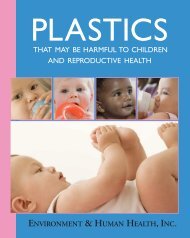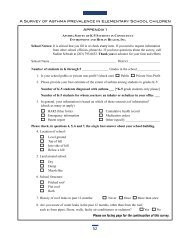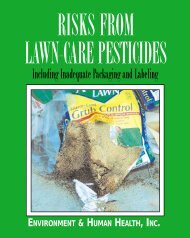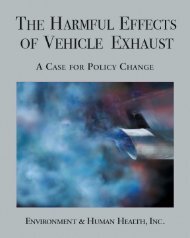LEED Report - Environment & Human Health, Inc.
LEED Report - Environment & Human Health, Inc.
LEED Report - Environment & Human Health, Inc.
- No tags were found...
Create successful ePaper yourself
Turn your PDF publications into a flip-book with our unique Google optimized e-Paper software.
The Green Building DebateF o r m a l d e h y d eFormaldehyde, a volatile organic compound (VOC) often used inbuilding materials, is identified as a human carcinogen and is a seriousairway irritant. It is designated a toxic air contaminant in California withno safe level of exposure. A significant association has been demonstratedbetween nasopharyngeal cancer and having lived 10 or moreyears in a mobile home, especially for mobile homes built in the 1950sto 1970s, when formaldehyde resin use increased.Numerous studies indicate that leukemia and neoplasms of the brainand colon may be associated with formaldehyde exposure. There is asignificant positive association between formaldehyde exposure andchildhood asthma. Associations between residential or school exposureto formaldehyde and respiratory symptoms have been reported, andphysician-diagnosed asthma and bronchitis are associated withincreasing concentrations of formaldehyde. 3Inside buildings, formaldehyde can off-gas from pressed woodproducts, such as plywood, particleboard and fiberboard.Formaldehyde is also found in insulation, durable press drapes, othertextiles and glues. One of the major sources of exposure is frominhalation of formaldehyde emitted from composite wood productscontaining urea-formaldehyde resins. Greater concentrations offormaldehyde have been associated with lower fresh air exchange, aswell as painting, varnishing and acquiring new wooden or melaminefurniture in the previous 12 months. 4Inside buildings,formaldehyde canoff-gas from pressedwood products, such asplywood, particleboard andfiberboard. Formaldehydeis also found in insulation,durable press drapes,other textiles and glues.<strong>LEED</strong> grants one point for documenting that composite wood andagrifiber products used on the interior of the building (defined as insideof the weather-proofing system) do not contain urea-formaldehyderesins (EQ Credit 4.4, Low-Emitting Materials: Composite Wood & AgrifiberProducts). Points are not awarded for using formaldehyde-freeinsulation, due to an assumption that the phenol-based formaldehydebinders used in batt fiberglass insulation do not emit formaldehyde at19







